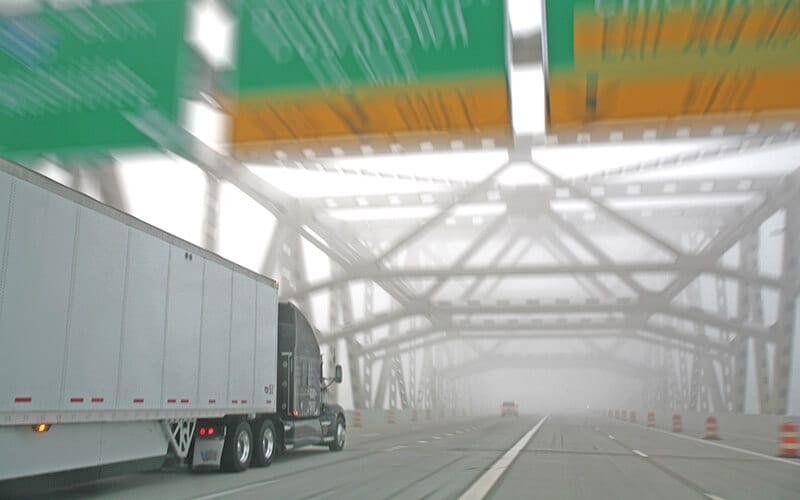Driving in a bad storm is dangerous for all drivers, but it can be especially dangerous for truck drivers. Truckers are often carrying as much as 80,000 pounds of weight through all kinds of situations. We’ve talked before about snow and ice, but what about summer conditions like rainstorms, high winds, floods, and even tornadoes?
There are some basic precautions all truckers should take even if the weather is clear and sunny, but during extreme weather, there are even more things to consider.
GENERAL SAFETY TIPS
Most of these safety tips are basically the same for all motorists. Mostly they are common sense things, but it never hurts to hear them again, just to keep them top of mind.
- First and foremost, Buckle Up! – It’s the law, and it will save your life.
- Don’t Use Your Cell Phone While Driving – Talking, texting, and surfing the internet on your cell phone distracts you from the road, so don’t do it, unless you have a Bluetooth, hands free option. Even then, it’s critical you pay attention to what you are doing. If you must make or take a call, keep it brief.
- Follow the Speed Limit – Be sure to check for special truck speed limits as well.
- Do Not Use Drugs or Alcohol Behind the Wheel – Drugs and alcohol impair your judgment, and endanger yourself and others. Plain and Simple.
- Map Out Your Trip – The more you plan your journey, the safer it will be.
- Mind the Space You Need for Your Rig – Know your truck’s height and weight and be mindful of them to avoid tight circumstances.
- Slow down for Turns, Curves, Lane Changes, etc.
- Keep a Comfortable Stopping Distance – 18-wheelers can’t stop on a dime. Give yourself plenty of space and time.
- Check the Weather – Know what Storms may be happening in the area you are headed to.
- Eat Healthy, and Get Plenty of Rest – A Good night’s sleep and a healthy diet works wonders for staying alert during a long haul, especially.
DRIVING IN HIGH WINDS
Drivers often think only a mighty gust will impact an up to 80,000-pound piece of machinery. But when rigs drive through open spaces, tunnels, highway overpasses, and mountains during strong winds these areas become wind tunnels that threaten to derail your rig. So, stay alert, keep both hands on the wheel, and be prepared for the gust to try and push you out of your lane. These same basic rules apply if you must drive through a hurricane.
DRIVING IN RAIN OR DURING A THUNDERSTORM
Driving through heavy rain presents the danger of hydroplaning across slick roads. Always check your speed, your stopping distance, and your alertness. If thunder and lightning accompany the rain, that presents even more danger. A lightning strike or down power line creates a high-voltage crisis for a truck driver. If an electric line is touching your truck, do not get out. Instead, try to back up. If you can’t do that either, call for help.
WHAT SHOULD YOU DO IN CASE OF A TORNADO?
Tornadoes are very dangerous and unpredictable, as they can change direction and shift their path in a matter of seconds. They also create debris that will fly fast and furious from every direction, and is much more life-threatening than the tornado itself. If a tornado approaches while you are driving, get off the road immediately! Try to find shelter somewhere indoors away from the path of the tornado. Avoid stopping under bridges and tunnels – This is where you will find funnel winds, which are very dangerous. Stay low – If you are stuck in your rig, keep your seatbelt on, leave the truck running so the airbags will function, duck down as low as you can (below the windows), and cover your head with your hands or a blanket. Even better if you can leave your truck and lie low in a ditch.
USE A WEATHER APP TO STAY INFORMED
Knowing about impending extreme weather before you drive into it can be lifesaving. Luckily, there are plenty of trustworthy free weather apps out there for all cell phone types. The Weather Channel, AccuWeather, and Storm Shield are a few commonly used apps. Downloading one of them to your phone is quick and easy. We are fortunate to live in times where this kind of information exists at your fingertips. Be sure to take advantage of it.
Is there a recommended method for checking the truck’s height and weight to ensure accuracy before a trip?
Use Weigh Stations and Portable Scales: Truckers can use public weigh stations or invest in portable wheel weighers to check their vehicle’s weight. For height, while specific tools to measure truck height are less common, truckers should refer to their vehicle’s manual and any height indicators provided by the manufacturer. Before embarking on a journey, especially if the load changes, truckers should ensure their vehicle complies with the height and weight restrictions of the routes they plan to take. Additionally, using a truck-specific GPS can help identify routes with restrictions based on the truck’s dimensions.
What are the best practices for maintaining a healthy diet on the road, considering the challenges of long-haul trucking?
- Plan Meals and Snacks: Truckers can plan their meals and snacks ahead of time, opting for healthy options like fruits, vegetables, lean proteins, and whole grains.
- Use a Cooler or Portable Fridge: Keeping a cooler or portable fridge in the truck allows for storing fresh produce and healthy meals, reducing reliance on fast food.
- Cook in the Truck: Portable cooking appliances such as slow cookers, portable grills, or microwave ovens can help in preparing healthy meals directly in the cab.
- Stay Hydrated: Drinking plenty of water throughout the day is crucial for overall health and helps avoid sugary drinks.
- Look for Healthier Options at Truck Stops: When dining out, look for truck stops and restaurants that offer healthier menu options, such as salads, grilled chicken, or fish.
Can the use of hands-free cell phone devices still pose a distraction, and if so, how can truckers minimize this risk?
- Use Voice Commands: Many hands-free systems allow for voice commands to make calls, send texts, or use navigation, reducing the need to look away from the road.
- Limit Conversations: Keep phone conversations brief and avoid engaging in stressful or emotional discussions that could divert attention from driving.
- Set Expectations with Callers: Inform friends, family, and work colleagues that you might need to end calls abruptly if driving conditions require full attention.
- Prepare Before Driving: Set up your navigation and make any necessary calls before hitting the road to minimize the need for interaction with devices while driving.
- Use Do Not Disturb: Many phones have a “Do Not Disturb While Driving” feature that can automatically respond to calls and messages, letting others know you’re driving and will respond later.
Disclaimer: The information in this article is based on the data available as of its writing and is meant to inform and guide prospective CDL trainees. For the most current information and specifics about CDL training programs, please contact SAGE Truck Driving Schools directly.

